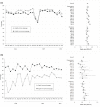Persistent Disparities in Pediatric Health Care Engagement During the COVID-19 Pandemic
- PMID: 37013845
- PMCID: PMC10076159
- DOI: 10.1177/00333549231163527
Persistent Disparities in Pediatric Health Care Engagement During the COVID-19 Pandemic
Abstract
Objective: The COVID-19 pandemic has disrupted traditional health care, including pediatric health care. We described the impact of the pandemic on disparities in pediatric health care engagement.
Methods: Using a population-based cross-sectional time-series design, we compared monthly ambulatory care visit volume and completion rates (completed vs no-show and cancelled visits) among pediatric patients aged 0-21 years in 4 states in the mid-Atlantic United States during the first year of the COVID-19 pandemic (March 2020-February 2021) with the same period before the pandemic (March 2019-February 2020). We used unadjusted odds ratios, stratified by visit type (telehealth or in-person) and sociodemographic characteristics (child race and ethnicity, caregiver primary language, geocoded Child Opportunity Index, and rurality).
Results: We examined 1 556 548 scheduled ambulatory care visits for a diverse pediatric patient population. Visit volume and completion rates (mean, 70.1%) decreased during the first months of the pandemic but returned to prepandemic levels by June 2020. Disparities in in-person visit completion rates among non-Hispanic Black versus non-Hispanic White patients (64.9% vs 74.3%), patients from socioeconomically disadvantaged versus advantaged communities as measured by Child Opportunity Index (65.8% vs 76.4%), and patients in rural versus urban neighborhoods (66.0% vs 70.8%) were the same during the remainder of the first year of the pandemic as compared with the previous year. Concurrent with large increases in telehealth (0.5% prepandemic, 19.0% during the pandemic), telehealth completion rates increased.
Conclusions: Disparities in pediatric visit completion rates that existed before the pandemic persisted during the pandemic. These findings underscore the need for culturally tailored practices to reduce disparities in pediatric health care engagement.
Keywords: COVID-19; health care utilization; health disparities; telehealth.
Conflict of interest statement
The authors declared no potential conflicts of interest with respect to the research, authorship, and/or publication of this article.
Figures




References
-
- Martin K, Kurowski D, Given P, Kennedy K, Clayton E. The impact of COVID-19 on the use of preventive health care. April16, 2021. Accessed November 17, 2021. https://healthcostinstitute.org/hcci-research/the-impact-of-covid-19-on-...
Publication types
MeSH terms
Grants and funding
LinkOut - more resources
Full Text Sources
Medical

